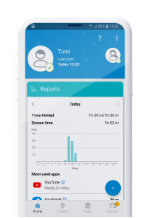Hey PUG! - Identity Theft
Finn thinks his password is strong enough to keep his mom’s valuable data from online theft. PUG and Miki are not so sure.
Nearly every parent worries about keeping their children safe online. New technologies emerge every day, from the latest version of the iPhone to new apps for social media, chat, and multimedia sharing. Today, more than 50% of U.S. children have a smartphone by age 11. For parents, it can be difficult to keep up with potential online threats.
Sometimes, the internet really does feel like the Wild West. Yet, threat researchers and internet safety organizations regularly publish data to help parents get a grip on the most frequent problems that kids run into online. So, if you need to get up to speed, here are the top threats kids face today online:
The same threats we were raised to avoid in the streets now face children online. According to research from The Center for Cyber Safety and Education, 40% of kids in grades 4-8 have chatted or connected with a stranger online. Of that 40%, the available data is sobering:
Willingly or unwillingly, children will likely come across explicit, sexual, or otherwise inappropriate content online. This includes sexual imagery and pornography, violence, and hate speech. The problem is widespread, as our survey of recent research quickly revealed:
And then, of course, there’s name-calling. The statistics suggest that cyberbullying is on the rise. Beyond hurling ad hominems and disparaging remarks, cyberbullying includes psychological pressure, harassment, physical threats, and so on. It’s a major problem that can have damaging consequences.
As the statistics indicate, cyberbullying is trending in the wrong direction:
While not as statistically prominent as some of the other online threats, sexual solicitation is still quite common and—in many ways—more acute in terms of potential repercussions. Ask any parent: sexual solicitation and online predators are high on the list of digital threats.
As pressing as these online threats are for kids and their parents, there are some effective strategies that can be used to protect against online threats.
Whether you agree with its central premise or not, the film “The Social Dilemma” makes one thing clear: so many risks inherent to frequent internet usage can be avoided by simply putting the phone down. Otherwise known as “behavioral avoidance” of services, applications, and platforms, this strategy is premised on interacting with the device less.
That could mean:
It’s one thing to have an account on, for example, Instagram, Facebook or TikTok. It’s another to post personal pictures, written content, and links. By self-monitoring, young people can avoid sharing sensitive information on their social network profiles or other online accounts, thus avoiding some of the risks that come along with posting intimate content and communicating with people they don’t know personally.
You don’t have to post just because you have an account. (Of course, asking kids to abstain from posting to social media might be asking a lot.)
Instrumental action is an umbrella term for device-level interventions, such as installing protective software or changing profile settings. Again, asking kids to do this on their own probably isn’t realistic. However, parents can certainly take it upon themselves, even if they lack technical expertise.
Here are two action items that we recommend:
As parents ourselves, we understand how difficult it is to keep up and compel children to self-monitor online. If it weren’t an uphill battle, we wouldn’t be talking about it! But we do think staying ahead of the curve is possible. It just means getting educated in a few important areas:
Which brings us to our final point. Despite the volume of threats facing kids online today—despite each new social media app, smartphone version and internet technology—parents still serve as the lighthouse for what is right and wrong. To that end, the best thing parents can do is begin the conversation so that the journey toward safer online conversations is shared, not dictated.


With ESET Parental Control for Android
Try free for 30 daysFinn thinks his password is strong enough to keep his mom’s valuable data from online theft. PUG and Miki are not so sure.
There are certain things you can do to make both the online world and your kids´ identity more secure and protected. Read this blog to find out more.
How can you help protect your kids from ghosts, ghouls and goblins creeping on the internet?